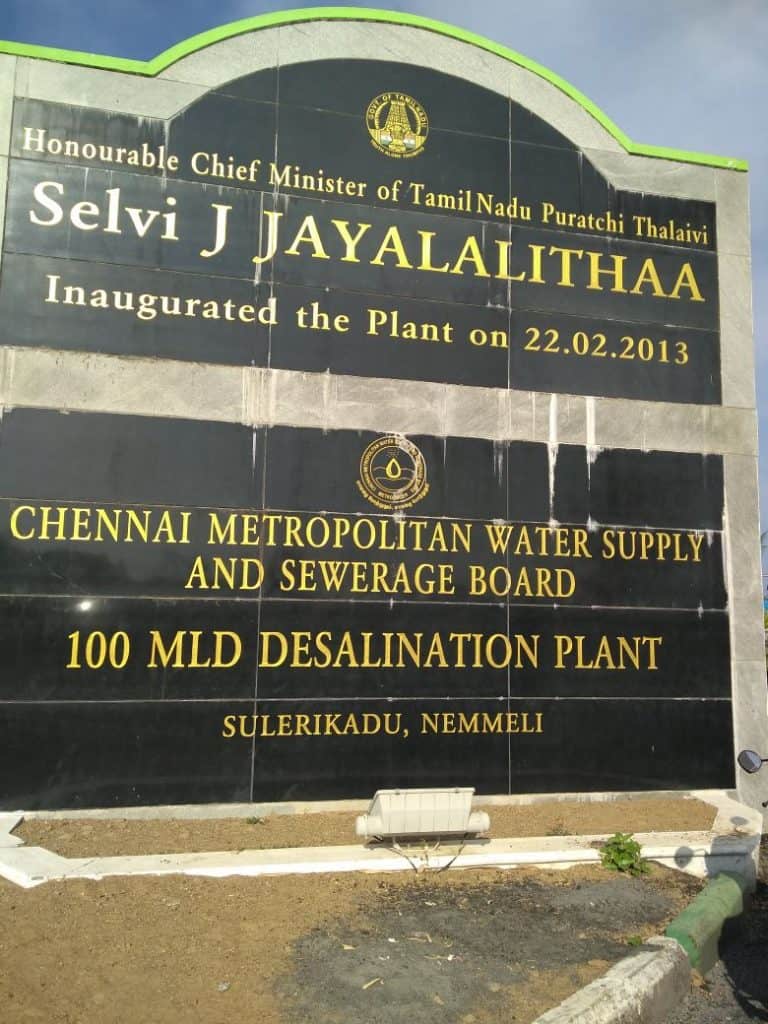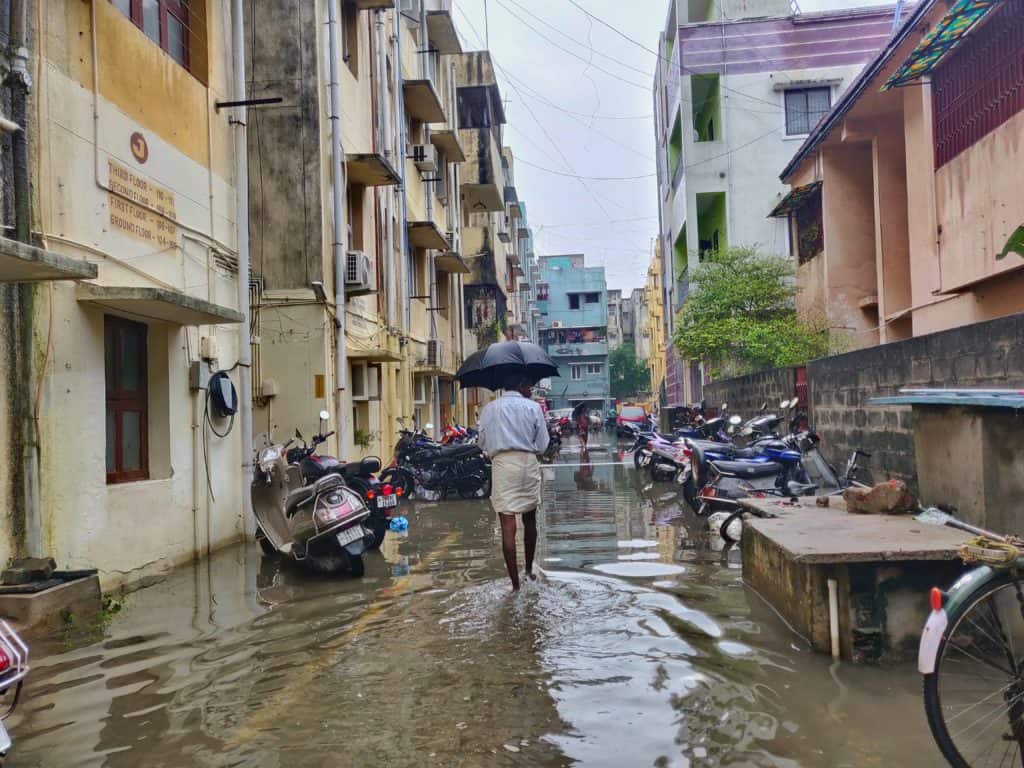Last year, Chennai experienced intense rains and flooding yet again, bringing the city to a standstill for days. Excess flooding in the city has been associated with poor planning and urban development projects over the years. Rapid urbanisation in erstwhile agricultural lands and wetlands, and increased concretisation have altered the natural flow of rainwater. This is what has often led to debilitating floods.
Existing infrastructure to manage flooding has been criticised by city dwellers and environmentalists for incomplete construction, lack of topographic study before implementation, and lack of linking drains to natural channels.
A growing concern is the fact that such measures are not ‘environmentally sustainable’ – while importance is given to draining away water from flooded areas via storm water drains (SWDs), there is not much attention paid to conserving and repurposing the water. Current measures such as SWDs, gutters and pumps, are often dubbed as ‘grey’ measures’.
Read more: All that’s wrong with stormwater drains in Chennai and how to fix them
Many are now pointing to ‘nature based solutions’ (NBS) — dubbed as ‘green and blue’ infrastructure — as a key alternative or complementary measure, to mitigate the effects of floods in the city. Before we elaborate on this, we need to first understand the existing modes in place for flood management in the city.
Existing flood management infrastructure
The storm water drain (SWD) networks consist of a set of pipes which carry run-off stormwater to nearby water bodies such as rivers, lakes, ponds and the sea. Many of these drains are to be connected to natural canals, which then feed into the main water bodies. These canals include the Otteri Nullah in Kilpauk, Mambalam Drain, PT Rajan Salai canal, Mirigambakkam Canal, Captain Cotton canal, Buckingham Canal, etc. Many of these are older man-made channels constructed along the natural slopes in the topography. They usually range from 20 ft to 50 ft in width, however their size has decreased over the years, and many have become choked with waste.
As of January 2021, the corporation has constructed 8,835 drains spanning an area of 2051 square km. A portion of these drain networks were constructed under public-private partnership projects such as JNNURM, Chennai Mega City Development Mission, Integrated Storm Water Drain Project and Smart City Project. They have been criticised for faulty execution as existing SWDs were allegedly destroyed with new ones being built over them as part of these projects. Activists have highlighted how, despite publicity and huge investments in constructing these networks, many of the areas that came under these projects were water-logged during last year’s downpour.
Read more: Flooding in T Nagar raises a lot of questions for the smart city mission
In addition to SWDs, pumps are also commonly used in heavily flooded areas. Rainwater harvesting, formation of community tanks and wetland restoration are also key measures adopted as part of flood management systems.
How do these fall short?
Dayanand Krishnan, a GIS consultant and member of civic action group, Chitlapakkam Rising, mentions how flood management and general urban planning do not prioritise recharging of the ground i.e. allowing water to percolate into the ground for storage and repurposing. This can be seen in how the majority of funds have historically been allocated for SWD projects, even in areas that do not even require such infrastructure, as was the case along the sandy Kottivakkam-Uthandi stretch.
The same is reflected in a 2019 report on Chennai’s water system by the Chennai Resilience Center: “Flood management in Chennai has not been thought about in an integrated manner that incorporates rain water harvesting, recognition of natural sinks and marshlands and contributions of the traditional eri (or tank) system to underground recharge.”
Dayanand explains how even in streets where these drains are required, the SWD system has often led to large scale wastage of water and has exacerbated flooding. This is because there is an uncontrolled flow of storm water into the SWDs that were initially built to hold much lower volumes of storm water inflow. Ultimately the rainwater is lost to the sea or stagnates in floods, and there is no proper cycle that allows for using the water.
While desalination plants are constructed outside the city to recycle and supply water, these are high cost, high energy projects especially considering the amount of transportation of water that is required.

Read more: ECR residents do not want a storm water drain; here’s why
Nature based solutions as an alternative
Nature based solutions or ‘ecosystem-based adaptation’ measures propose to make use of natural processes and ecosystems for reducing the effects of natural disasters such as floods, landslides, erosion and drought. These can either be completely green — consisting of only ecosystem elements, or hybrid — a combination of ecosystem elements and hard or ‘grey’ engineering services. These solutions are becoming popular in megacities and wealthier countries, and are often adopted in the name of sustainable development and planning, in urban landscapes.
As explained in the website of City of 1000 tanks, a Chennai-based multi-stakeholder NBS project, nature based solutions are specifically engineered to absorb and filter pollutants through organic and mechanical devices. The approach has been developed as a means to address climate change adaptation in densely urban areas.
Use of blue-green infrastructure for flood management has taken place in many other urban landscapes.
For example, in Dresden Germany, a network of urban community gardens are being built to help increase water retention and conservation in densely urban areas.
In Chicago, greening of rooftops has been adopted and has managed to prevent storm water runoff by 30%.
Sheffield has recently incorporated permeable pavements along with retention sumps, bioswales, perforated underdrains, and rain gardens to increase natural absorption and collection.
Conversion of open spaces into parks for absorption of rainwater has been done in a number of cities such as Paris, Singapore, Rotterdam and New Orleans. Bethenheim Water Square in Rotterdam is a key example of an integrated blue-green and grey flood management system. The park is a conventional play and sports area with a porous surface also acting as a storm water catch basin.
Implementing nature-based solutions: Where does Chennai stand?
In terms of sustainable and effective solutions that could be applied in Chennai, Dayanand suggests methods similar to Singapore’s rain garden model where there is importance given to recharging of the ground and harvesting of water in development projects.
Dayanand suggests that city planning should also naturally account for water retention: “When the CMDA gives a new development plan where they list a new Open Space Reserve (OSR), they should give a condition to have a water body. Instead of completely converting it into a park, they can partially allocate around 25% of the area for constructing a pond.”
According to Eva Pfannes, from City of 1000 tanks, as the city becomes more dense, space needs to be given for nature and water in the urban landscape, so as to allow for rainwater to come full circle. In the past, Chennai was able to do this through the use of the traditional eri system, presence of wetlands, and due to a much lower population density. Presently, however, space for collection of rainwater is not given much priority in the city.
City of 1000 Tanks aims to revive traditional systems such as temple tanks and eris, and provide space for existing sandy ground to absorb water. On speaking to members of OOZE (a Netherlands-based collective of architects and urbanists, part of the City of 1000 Tanks project), they stressed upon the importance of existing systems in place. “We are trying to combine both: ancient knowledge (eris and temple tanks), nature based solutions and the current functioning of the city,” said Eva.
One of the ongoing flagship projects of the organisation is reviving the Mylapore Temple tank system. The tanks ideally function as effective water recharge systems, as they collect water which is then recharged into Mylapore’s sandy layer. The sand filters the water prior to recharge. The project has developed a design to revive two temple tanks, transform open spaces into new tanks, and connect these via a network of nature based infrastructure along streets and roads.
A large part of designing involved research and interaction with communities living in the area. The organisation spoke to many street vendors, to see if these solutions could co-exist with those who move in and out of the area, and to even see if jobs could be created in the maintenance of these nature based solutions.
“Decentralisation really makes people the owners of these resources. When water is recycled and managed, it is owned by an external entity. When people can see these systems and can manage them, they are empowered to be in charge of these resources. they don’t have to depend on the government or a private entity for the maintenance of NBS.”
– Hsoc Mathai George of OOZE Architects

City of 1000 Tanks is also working on a pilot project to test NBS solutions in the Little Flower Convent in Mambalam. It is an ongoing project that aims to pilot a Chennai specific water balance model to be upscaled to different parts of the city. The model consists of septic tanks, constructed wetlands, bioswales and detention parks. In addition to rainwater harvesting measures, the pilot project gives importance to constructed wetlands with reeds for treatment of wastewater collected in open spaces. The school could potentially benefit by receiving 2500 litres of water per day, as a result.
The organisation is working on a number of other NBS projects as well, such as providing water collection and in-situ NBS for sewage treatment in the Chitra Nagar-Kotturpuram informal settlements along the banks of the Adyar river; stormwater absorption measures in Koyambedu market, and many more.
What should be kept in mind?
An important principle of nature-based flood management is the integration of the natural ecosystem in the flood management process. However, it calls for proper assessment of local environmental conditions and topography. For example, attempts at restoration and flood mitigation via planting of exotic species have led to adverse effects in certain ecosystems.
For example, planting mangroves to reduce storm surges and reduce flood risk is a common NBS approach. However, if they are planted in areas where mangroves don’t grow naturally, for example in seagrass ecosystems, they can cause harm to the local ecosystem, as they are planted on feeding areas for dugongs and in the living area for fish, shellfish and shore birds.
Giriraj Amarnath, a research lead specialising in water risk management at the International Water Management Institute, also stresses on the importance of “co-development with human systems” in implementing these solutions. “People need to be encouraged to participate in the process, not just the NGOs or government officials. These solutions should be based on the needs and capacities of communities (living in the concerned areas) in terms of how waste water could be reduced and reused for example”.
Giriraj also mentions how flood management solutions need to be planned for the long term, so as to adapt to climate change-induced disasters and environmental conditions.
“Nature based solutions should be planned for the next three to four decades. It cannot be simply an ad hoc investment. It (NBS) also cannot just look at flood management alone. Instead, stakeholders must consider a collective approach. Planning should include questions about how populations can be empowered to implement and maintain blue green infrastructure, how sustainability can be achieved on a long term basis, how different departments/sectors can come together in the process.”
